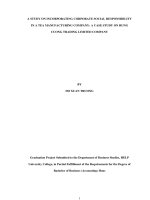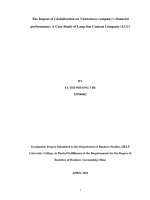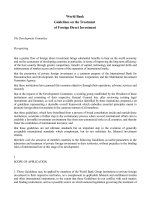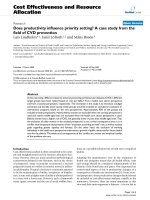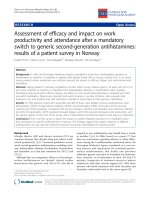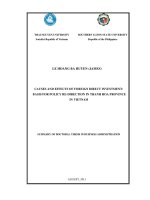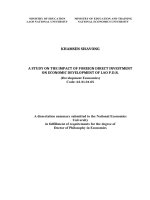Impacts of foreign dirrect investment on labor productivity of manufacturing industry a case of vietnam
Bạn đang xem bản rút gọn của tài liệu. Xem và tải ngay bản đầy đủ của tài liệu tại đây (6.02 MB, 69 trang )
.,.._
~<:;.
•·.. ;•
.
-
-
-
- -- ---------------
··,
',;
f./
UNIVERSITY OF ECONOMICS
HO CHI MINH CITY
VIETNAM
.
'·-~
-~
'
INSTITUTE OF SOCIAL STUDIES
THE HAGUE
THE NETHERLANDS
VIETNAM- NETHERLANDS
PROGRAMME FOR M.A IN DEVELOPMENT ECONOMICS
_,~ '}~
:
'');,A,.,
~-
·~;-:
~...·.·
:~
:
,· r
•..:
.:.:'
.
J<
• .::'"
".>
ON LABOR PRODUCTIVITY OF
...
,......t
_i{
IMPACTS OF FOREIGN DIRECT INVESTMENT
·t:·
'. ~~~
l't·
MANUFACTURING INDUSTRY:
.{-;
~
.-~.·.·,
~. :·~
~
A CASE OF VIETNAM
BY
VO KHOI NGUYEN
MASTER OF ARTS IN DEVELOPMENT ECONOMICS
., .
HO CHI MINH CITY, APRIL 2011
UNIVERSITY OF ECONOMICS
HO CHI MINH CITY
VIETNAM
'
INSTITUTE OF SOCIAL STUDIES
THE HAGUE
THE NETHERLANDS
VIETNAM- NETHERLANDS
PROGRAMME FOR M.A IN DEVELOPMENT ECONOMICS
IMPACTS OF FOREIGN DIRECT INVESTMENT
ON LABOR PRODUCTIVITY OF
MANUFACTURING INDUSTRY:
A CASE OF VIETNAM
A thesis submitted in partial fulfilment of the requirements for the degree of
MASTER OF ARTS IN DEVELOPMENT ECONOMICS
By
VO KHOI NGUYEN
Academic Supervisor:
PhD. NGUYEN VAN PHUONG
HO CHI MINH CITY, APRIL 2011
CERTIFICATION
I hereby certify this thesis has not been submitted for any degrees and is not being
currently submitted for any other degrees.
I also certify that, to the best of my knowledge, and any help received in preparing the
thesis and all sources used have been acknowledged in the thesis.
Signature
Vo Khoi Nguyen
Date: April, 2011
ACKNOWLEDGEMENT
With the valuable guidance and advices from Vietnam-Netherlands program lecturers
and friends, I am really grateful to what they have done for my thesis completion.
First of all, I would like to illustrate my largest gratitude to my supervisor, PhD.
Nguyen Van Phuong who always gives useful and valuable advices and enthusiastic
comments for my thesis.
I am grateful for Professor, Peter Calkins for his precious advice and comments from
the initial ideas of the thesis.
I also express my special thanks to Professor, Nguyen Trong Hoai for his lectures in
econometrics and PhD. Cao Hao Thi, the lecturer of Vietnam-Netherlands project, for
his kind help and instructions in data analysis by Eview software.
And finally, I would like to show my special thanks to my friends in MDE class 15 for
their supports during my research completion.
ii'
II
ABSTRACT
The paper exammes whether foreign direct investment mcreases the overall labor
'
productivity in Vietnam. Using panel data at firm level from the manufacturing sector,
it finds robust evidence of the positive impacts from foreign direct investment on labor
productivity. Moreover, it also confirms the positive correlation of labor productivity
and capital intensity, labor quality and economic scale. However, it should fail to
establish any significant relationships between productivity and location; and industry.
And the findings illustrate foreign enterprises do not make more productive than
private firms.
'
Ill
TABLE OF CONTENTS
CHAPTER 1 INTRO D U CTI0 N -------------------------------------------------------------- 1
1.1.
Introduction --------------------------------------------------------------------------------- 1
1.2.
Research objective and questions-------------------------------------------------------- 2
1.3.
Research hypotheses----------------------------------------------------------------------- 2
1.4.
Organization of the study -----------------------------------------------------------------2
CHAPTER 2 LITERATURE REVIEW----------------------------------------------------- 3
2 .1.
Theoretical background ------------------------------------------------------------------- 3
2.2.
Economic theories-------------------------------------------------------------------------- 4
2.2.1.
Cobb-Douglas production function------------------------------------------------------ 4
2.2.2.
Theoretical framework ofFDI impact on labor productivity ------------------------5
2 .3.
Empirical studies --------------------------------------------------------------------------- 6
2.3 .1.
Channel effects of foreign direct investment------------------------------------------- 6
2.3 .2.
Impacts of FDI on labor productivity --------------------------------------------------- 7
2.4.
Summary ------------------------------------------------------------------------------------ 8
CHAPTER 3 AN OVERVIEW OF FDI IN VIE TN AM---------------------------------- 9
3 .1.
Introduction --------------------------------------------------------------------------------- 9
3 .2.
Overview of FDI inflows ( 1988-2009) -------------------------------------------------- 9
3.2.1.
FDI inflows in period 1988 - 2009------------------------------------------------------- 9
3.2.2.
Some characteristics of foreign direct investment in Vietnam--------------------- 11
3 .3.
The role of FDI in national economy-------------------------------------------------- 19
3.3.1.
The role ofFDI in national economic growth---------------------------------------- 20
3.3 .2.
The role of FDI in employment and human resources ------------------------------ 21
3 .4.
Overview of labor productivity in A SEAN------------------------------------------- 21
IV
3 .5.
Summary ---------------------------------------------------------------------------------- 23
CHAPTER 4 RESEARCH METHODOLOGY------------------------------------------ 24
4.1.
Model specification---------------------------------------------------------------------- 24
4.2.
Description of variables ----------------------------------------------------------------- 24
4.2.1.
Dependent variable labor productivity (Labprod) ----------------------------------- 24
4.2.2.
Explanatory variables-------------------------------------------------------------------- 25
4.3.
Data collection---------------------------------------------------------------------------- 2 7
4. 4.
Estimation strategy----------------------------------------------------------------------- 2 8
4 .5 .
Summary ---------------------------------------------------------------------------------- 29
CHAPTER 5 RESULT ANALYSIS-------------------------------------------------------- 30
5 .1.
Introduction------------------------------------------------------------------------------- 30
5 .1.1.
Descriptive statistics of variables ------------------------------------------------------ 30
5.1.2.
Multiple regression result --------------------------------------------------------------- 37
5.2.
Analysis and discussion about the finding results ----------------------------------- 41
5. 3 .
Summary ---------------------------------------------------------------------------------- 44
CHAPTER 6 CONCLUSIONS AND RECOMMENDATIONS---------------------- 45
6.1.
Conclusions ------------------------------------------------------------------------------- 45
6 .2.
Recommendations------------------------------------------------------------------------ 4 5
6. 3.
Limitation --------------------------------------------------------------------------------- 4 7
Reference-------------------------------------------------------------------------------------------- 4 8
Appendices ----------------------------------------------------------------------------------------- 51
•
v
LIST OF TABLES
Table 3.1: FDI projects licensed from 1988 to 2010 by kind of economic activity ...... 12
Table 3.2: Employed population by ownership from 2000-2009 ................................. 21
Table 3.3: Average annual labor productivity growth by Industry(%) ........................ 22
Table 4.1: Definition summary of variables .................................................................. 27
Table 5.1: Statistical summary of sample ...................................................................... 31
Table 5.2: Distribution of explanatory variables in logarithm form ............................. 34
Table 5.3: Correlation matrix spreadsheet without logarithmic form ........................... 35
Table 5.4: Correlation matrix spreadsheet using logarithmic form ............................... 35
Table 5.5: Regression result from Pooled Least Square ................................................ 37
Table 5.6: Regression result from fixed effects model.. ................................................ 38
Table 5. 7: Regression result from random effects model.. ............................................ 39
Table 5.8: Hausman test result ...................................................................................... 40
Table 5.9: Regressed result summary ............................................................................ 41
Table 5.10: Distribution of explanatory variables without logarithm form .................. 51
Table 5.11: Descriptive statistics of variables in three types of enterprises .................. 58
•
Table 5.12: Result from fixed effects model with PCSE .............................................. 59
Table 5.13: Result from fixed effects model with Dummy variable Dfshare ............... 60
VI
LIST OF FIGURES
Figure 3.1: FDI inflows in period 1988- 2009 ----------------------------------------------10
Figure 3.2: Structure of investment at current prices by types of ownership from 19952008 ------------------------------------------------------------------------------------------------14
Figure 3.3: FDI inflows licensed by region --------------------------------------------------15
Figure 3.4: FDI inflows (million USD) by country ofregion------------------------------17
Figure 3. 5: FDI inflows in manufacturing sector --------------------------------------------18
Figure 3.6: Industrial output value in manufacturing sector by ownership --------------19
Figure 3.7: Structure ofGDP at current prices by ownership period 1995-2009-------20
Figure 3.8: Comparative Labor Productivity Performance---------------------------------23
Figure 5.1: Distribution of labor productivity without logarithm form-------------------32
Figure 5.2: Distribution of labor productivity in logarithm form--------------------------33
Figure 5.3: Correlation between Labprod and Fshare in logarithm form----------------36
Figure 5.4: Distribution of correlation between labor productivity Labprod and capital
intensity Capint without logarithm form------------------------------------------------------ 52
Figure 5.5: Distribution of correlation between labor productivity Labprod and capital
intensity Capint in logarithm forms -----------------------------------------------------------53
Figure 5.6: Distribution of correlation between labor productivity Labprod and material
input purchases Scale without logarithm formS----------------------------------------------54
Vll
Figure 5.7: Distribution of correlation between labor productivity Labprod and material
input purchases Scale in logarithm forms ----------------------------------------------------55
Figure 5.8: Distribution of correlation between labor productivity Labprod and
proportion of skilled labor Skill without logarithm forms ----------------------------------56
Figure 5.9: Distribution of correlation between labor productivity Labprod and
proportion of skilled labor Skill in logarithm forms-----------------------------------------51
Vlll
- --
----
CHAPTER 1: INTRODUCTION
CHAPTER!
INTRODUCTION
1.1.
Introduction
The remarkable turnabout in economic fortunes and accelerated growth of Vietnam
economy is well known following Doi Moi in 1986. From growth rates of 3-4% in the
1980s, GDP growth accelerated to an average annual rate of 7-8% for the next 20
years, touching 9% in 2008. These promising achievements of the economic transition
resulted from the reform policies in the context of rapid globalization process. After the
promulgation of the Law on Foreign Investment in 1987, Vietnam integrated world
economy and joined ASEAN in 1995, APEC in 1998, ASEM in 2001 and WTO in
2007. During the economic transition from after 1986 to current years, many
investigators stated that foreign direct investment (FDI) played a crucial role helping
jumpstart to Vietnam's economy on its way to accelerating reform and socio-economic
growth. Such a large amount of FDI capital demonstrates that Vietnam's investment
environment is attractive and many foreign investors are interested in the local market.
It is consistent with the fact that FDI in Vietnam mainly concentrated on labor-
intensive and export-oriented manufacturing activities (accounting for 5,139 projects
with total committed capital of65.7 billion USD in period 2000-2009).
Therefore, this research is expected to answer whether FDI increases the overall labor
productivity in manufacturing industry. It helps policy makers and enterprise
management deliver effective policies for improving and maximizing local labor
productivity, enhancing export-oriented manufacturing industry and ensuring the
sustainable development among regions.
1
CHAPTER 1: INTRODUCTION
1.2.
Research objective and questions
The general objective ofthe research will study whether FDI increases the overall labor
productivity in Vietnam, as measured by value added per labor, focusing on three subindustries; food processing; textile, garment and footwear and electronics and
mechanics including state, private (non-state) and foreign firms located over the
country. Based on the research objective, the study will investigate the following
questions:
a) Does FDI significantly impact on labor productivity in Vietnam?
b) Does the impact of FDI on labor productivity differ significantly across provinces,
the ownership structure of firms?
1.3.
Research hypotheses
An expectation in the econometric model 1s to confirm the stgn and statistical
significance of following results:
a) FDI impacts positively on labor productivity of manufacturing industry in Vietnam.
b) Foreign sector makes labor productivity more increasingly than others.
c) The impacts ofFDI on labor productivity significantly differ across regions.
1.4.
Organization of the study
The research consists of six chapters. First chapter discusses the Introduction. The next
chapter is the Literature review. An overview of FDI in Vietnam is discussed in chapter
3. Research methodology in chapter 4 illustrates statistical model and data. Chapter 5
describes the result analysis and discussion. Finally, chapter 6 will be a concluding
section.
2
CHAPTER 2: LITERATURE REVIEW
CHAPTER2
LITERATURE REVIEW
2.1.
Theoretical background
The key independent variable of this research is foreign direct investment (FDI). There
are several ways to understand FDI such as International Monetary Fund's FDI
definition or United Nations' FDI definition. According to Organization for Economic
Co-operation and Development OECD (1996), FDI is clearly defined as follows:
"Foreign direct investment reflects the objective of obtaining a lasting interest by a
resident entity in one economy ("direct investor") in an entity resident in an economy
other than that of the investor ("direct investment enterprise"). The lasting interest
implies the existence of a long-term relationship between the direct investor and the
enterprise and a significant degree of influence on the management of the enterprise.
Direct investment involves both the initial transaction between the two entities and all
subsequent capital transactions between them and among affiliated enterprises, both
incorporated and unincorporated."
Besides OECD's FDI definition, GSO (2008) also explained FDI as the bringing of
capital into the host country in the form of money or any assets by foreign investors for
the purpose of carrying on investment activities in accordance with the provisions of
the law on foreign investment in Vietnam.
The dependent variable in this study is labor productivity. According to OECD (2001),
productivity is defined as a ratio of a volume measure of output to a volume measure of
input use. To measure labor productivity, it is commented that the three most
commonly used ways of input are: hours worked; workforce jobs; and number of
people in employment. Output per worker corresponds to the "average product of
3
CHAPTER 2: LITERATURE REVIEW
labor" and seemed to be contrast with the marginal product of labor, which refers to the
increase in output resulting from a corresponding marginal increase in labor input.
2.2.
Economic theories
2.2.1.
Cobb-Douglas production function
According to Cobb-Douglas (1928), they use production function as the functional
form to represent the relationship of an output to inputs. They estimated an aggregate
production function econometrically and the results presented to the economics
profession. It is known as "Cobb-Douglas production function" that is the most
simultaneous form in theoretical and empirical analyses of growth and productivity.
The production function has the formulation as follows:
Where:
•
Y denotes output, L: labor input, K: capital input
•
A is a constant depending on the units in which inputs and outputs are measured
•
a and
~
are the output elasticities of labor and capital, respectively. These values
are constants determined by available technology.
Output elasticity measures the responsiveness of output to a change in levels of either
labor or capital used in production, ceteris paribus. For example if a
=
0.1, a 1%
increase in labor would lead to approximately a 0.1% increase in output. The CobbDouglas production function is usually expressed in logarithmic form: logY= log A +
a log L + fJ log K which is useful and easy when performing a regression analysis.
4
--------,.----------- - - - - -
CHAPTER 2: LITERATURE REVIEW
2.2.2.
Theoretical framework of FDI impact on labor productivity
Based on Cobb-Douglas function, Liu et al. (200 1) examine the overall impact of FDI
on the Chinese electronics industry. Productivity function model (logarithmic form) is
normally suggested as follows:
LP = F (CI, FS, LQ, FP)
Where LP is used measures firm performance; CI is the capital-labor ratio; firm size
FS; LQ labor quality or human capital, and foreign presence FP.
Also investigating impacts from FDI, Blomstrom and Sjoholm (1999) examine the
effects of FDI on productivity. Y represents values added; K is (physical) capital
assets; L and FDI respectively denote labor and contribution by foreign partner in total
capital assets of firm i. The productivity function (log-linear form) will follow:
_y
__.!l_
LiJ
K
= F( _!!__, FDIiJ, SkilliJ, ScaleiJ, Dlndustry1 )
LiJ
In this productivity function, Skill measures the skilled labor and Scale denotes the
size/scale of the firm in the industry. Dlndustry is the industry-specific dummy
variable.
The picture is more specific, as the recent work by Peter, Jeremy and Chengqi (2006),
to investigate the impact of FDI on the productivity of China's electronics industry.
Value added per worker LP in a sub-sector, is a function of foreign presence FP, the
capital labor ratio KL; intangible assets per employee INT; labor quality LQ and fixed
assets per worker FS. The function model (logarithmic form) will be as below:
5
CHAPTER 2: LITERATURE REVIEW
2.3.
Empirical studies
2.3.1.
Channel effects of foreign direct investment
Relating to the impacts of foreign direct investment, Javorcik (2004) argues there are
varieties of direct effects and indirect effects. Under these effects, local companies
must improve competitive capabilities to pursue their competitors in the same sector
before elimination out of industry. These effects are referred to as horizontal spillovers.
Foreign enterprises have higher productivity than domestic firms and indicate a strong
direct effect from foreign investment to the productivity of individual firms (Mariam,
2003). This positive effect specifies the ways which a country receives the direct
effects of foreign investment are better than potential spillover benefits of technology
transfer.
The picture is more specific about the differences of technological gap between local
plants and its foreign competitors from empirical study conducted by Kokko, Tansini
and Zejan (1996). They conclude that there are significant differences in the impact of
FDI from two separately groups of small and high technology gaps, although there is
no sign of spillovers when testing on the entire sample. In another research, Aitken and
Harrison (1999) point out foreign share is positively correlated with productivity
levels. However, they also postulate that foreign equity participation has a negative
relationship with the productivity of domestic firms in an industry.
Although several statistical results confirm the positive effects of foreign direct
investment, there are some negative findings. For example, Miguel (2006) finds a large
pool of FDI inflows could not make the innovative "green field" investments to obtain
technological spillover effects in high priority sectors of the manufacturing industry.
Besides that, Peter, Jeremy and Chengqi (2007) also suggest that high inward FDI in
6
CHAPTER 2: LITERATURE REVIEW
Chinese domestic industry creates negligible productivity increase in low-technology
industries due to negative spillovers to local firms.
2.3.2.
Impacts of FDI on labor productivity
More recently, empirical evidences confirm FDI seems to have beneficial effects on the
economy of the host country, pointing out to improvements of labor productivity
increase, and gains in competitive efficiency and process innovations.
Making the investigation on the impact of FDI inflows, Blomstrom and Sjoholm
(1999) argue labor productivity is positively related to capital intensity, skilled labor,
capacity utilization and scale of operation. And they suggest that foreign ownership
takes an important role in term of the impacts on labor productivity in Indonesian
manufacturing industry. Moreover, they also indicate intra-industry spillovers from
foreign direct investment exist. However, they postulate that the productivity of
foreign-owned enterprises is not dependent on ownership structure. The same
conclusion is that FDI has a positive impact on labor productivity, especially in the
Chinese electronics industry conducted by Liu et al. (200 1). They specify labor quality
is the most contribution in an increase of labor productivity. It follows by firm size, and
then foreign presence. However, regarding to capital intensity, they conclude that it is
insignificant and not an important factor of labor productivity in this industry.
Furthermore, another empirical evidence confirmed FDI have beneficial effects on
overall labor productivity in the Irish manufacturing sector increased by 158 %
between 1991 and 1999 (Frances and Ali, 2005). Making the same investigation, Hsu
and Chen (2000) complement that small and medium enterprises own FDI increase
labor productivity in the industry. However, they also imply negative correlation
between labor productivity and large size firms.
7
CHAPTER 2: LITERATURE REVIEW
In order to discern more accurately the impact of FDI on labor productivity, Lutz and
Talavera (2004) report that the presence of FDI has a significantly positive influence
on labor productivity. And labor productivity turns out to be relatively different across
industries. However, it argues no significant differences on labor productivity for
investigated regions in the effects of FDI. In other research, Gangti and Kong (2000)
postulate the higher the investment in the larger cities, the higher the labor efficiency.
Especially, the labor efficiency through which labor-intensive industries receive more
FDI inflows is higher. Making the same investigation, Eric (2004) illustrates the
linkages among labor productivity or wages, and foreign ownership shares in Thai
manufacturing industry are relatively weak
Meanwhile, Duy (2009) uses cross sectional data at firm level and indicated results that
FDI positively impacted on labor productivity in Vietnam. And labor productivity is
positively related to capital intensity, but relatively different across industries and
regiOns.
Based on results from Duy's study, this research will be aimed to analyze more deeply
about FDI impacts on labor productivity of manufacturing sector in Vietnam with
panel data sets. Moreover, it will examine FDI factor as explanatory variable to test
first hypothesis.
2.4.
Summary
In general, this chapter focuses on theoretical model and empirical studies to
consolidate economic background concerning to the research. Moreover, it will lead to
withdraw the suggested model which established and presented in chapter 4.
8
CHAPTER 3: AN OVERVIEW OF FDI IN VIETNAM
CHAPTER3
AN OVERVIEW OF FDI IN VIETNAM
3.1.
Introduction
Foreign direct investment inflows have been increasing widespread since 1988 after
Vietnam launched a political and economic renewal campaign (Doi Moi) and opened
the market-oriented economy through the first Foreign Direct Investment Law
approved by National Assembly on December 29t\ 1987. Therefore, the purpose of
this chapter is to present the overview of FDI in Vietnam since 1988 after the FDI law
came into effect and the overview of labor productivity in A SEAN in general.
3.2.
Overview of FDI inflows (1988-2009)
3.2.1.
FDI inflows in period 1988- 2009
FDI inflows to Vietnam achieved significant results from the law on Foreign
Investment approved in 1987, reaching 37 projects with total registered capital at 342
million USD. From period 1988-1997, it impressed 2,341 projects, the total registered
capital and implementation capital reached at 35,020 and 12,347 million USD
respectively, especially coming at the peak with 10,164 and 2,714 million USD in
1996. However, due to the Asian Economic Crisis in year 1997, FDI inflows to
Vietnam seriously declined. Then FDI flows continued reducing rapidly at 2,566
million USD of total registered capital but resurged in 2000. After Vietnam's World
Trade Organization integration in 2007, it robustly achieved 1,557 projects with more 7
times of total registered capital and 4 times of total implementation capital when
compared with 1996. And FDI inflows suddenly dropped with total registered and
implementation capital at 10,108 million USD in preliminary 2009 due to global
financial crisis. It showed a drop of81.2% compared to same period in 2008. Of which,
9
CHAPTER 3: AN OVERVIEW OF FDI IN VIETNAM
3.2.2.
Some characteristics of foreign direct investment in Vietnam
3.2.2.1. FDI projects licensed from 1988 to 2010 by kind of economic activity
((*)Including supplementary capital to licensed projects in previous years)
As shown in table 3.1, statistical data illustrated Vietnam government's tendency is
moving economy to focus main sectors which create effective productivity and
increase competitive capability in region. Especially, the highest ratio of FDI inflow
sources mainly concentrated on the manufacturing sector with 7,166 projects and
85,191 million USD, corresponding to 58.79% of total projects and 38.88% of total
registered capital. This sector has taken the main role in increasing overall
productivity. Meanwhile, industry of electricity, gas and water supply has not achieved
remarkable results from FDI inflows. Generally for the whole year of 2009, the
industrial output value was estimated at VND 696.6 trillion, grew by 7.6% as against
2008, of which, the state sector rose by 3.7%; the non-state sector by 9.9% and the FDI
sector by 8.1% (petroleum and gas by 9.2%, others by 8% ).
While electricity, gas and water supply have the lowest number of projects invested but
stay in the second position of average capital size of 62.63 million USD per project.
The results in the large concentration of capital size in such areas also originate from
government's
attracting
investment
policies
m
improving
and
developing
infrastructures on the way of international integration. These impressive results have
shown the manufacturing industries take an integral role in national economy and
contribute to the process of Industrialization and Modernization.
II
CHAPTER 3: AN OVERVIEW OF FDI IN VIETNAM
Table 3.1: FDI projects licensed from 1988 to 2010 by kind of economic activity
No
Kind of economic activity
1
2
3
4
5
6
7
8
9
10
11
12
13
14
15
Agriculture and forestry
Fishery
Mining and quarrying
Manufacturing
Electricity, gas and water supply
Construction
Wholesale and retail trade;
Hotels and restaurants
Transport; storage and communications
Financial intermediation
Real estate, renting business activities
Education and training
Health and social work
Recreational, cultural, sporting activities
Social and personal service activities
Total
129
78
Percentage
I
total
projects
4.62
1.34
1.08
58.79
0.52
4.27
2.37
2.90
3.49
0.56
16.75
1.03
0.59
1.06
0.64
12,189
100(%)
Number of
projects
563
163
132
7,166
63
520
289
353
426
68
2,042
125
72
36,130
542
10,981
85,191
2,125
7,952
958
18,128
7,255
1,026
45,703
264
1,010
1,796
58
Percentage
I
total
capital
16.49
0.25
5.01
38.88
0.97
3.63
0.44
8.27
3.31
0.47
20.86
0.12
0.46
0.82
0.03
219,119
100(%)
Registered
capital
(miL USD)
Source: Author's calculation based on the data ofGSO 2010
An average capital size per project has reduced continuously year by year down to 5.66
million USD after obtaining the peak in 1996 and then it bottomed at 3.71 million USD
per project in 2002. In current years, the capital size per project has increased
considerably and up to preliminary 2008 this average capital size per project has
reached at 54.66 million USD per project dramatically, the highest point since 1988.
This boom was obviously generated from the result of Vietnam's WTO joining in
2007. As illustrated from table 3.1, it is to figure out that the highest average capital
scale is implemented mainly in mining and quarrying with 84 million USD per project.
12
CHAPTER 3: AN OVERVIEW OF FDI IN VIETNAM
3.2.2.2. Structure of investment by ownership
Due to numerous reasons concerning to government's restriction regulations of setting
up 100% foreign owned enterprises, complicated policies for this kind of investment,
till 1995, FDI enterprise's capital including both wholly foreign owned enterprises and
joint ventures contribute around 30% of total social investment capital. Although the
proportion is unstable and changeable in decreasing tendency for many years later,
state and none-state enterprises' ratio increased steadily by years. As figure shown,
industrial output value in the manufacturing sector by foreign firms is thriving
gradually from 18.1% (15,084 billion VND) in year 1995, jumping to 42.0% (259,783
billion VND) in preliminary 2009. Particularly, foreign sector created outstanding
results of output value with 17 times in year 2009 higher than that of year 1995.
Meanwhile, industrial output value from non-state sector reduced slightly in period
1995-1999, and then increased in period 1999-2009, reaching 39.2% in 2009.
Otherwise, state owned firms created industrial output value decreasingly from 52.1%
in 1995 dropping to 18.8% in 2009. In preliminary 2008, the capital contribution of
FDI enterprises reached at 31% equivalent to 192,360 billion VND meanwhile nonestate ones obtained 40% and 244,081 billion VND higher than state sector with just
29% and 174,435 billion VND respectively. The exceeding ratio of non-state
enterprises over state sector comes from different reasons however it is also the results
ofFDI spillover affects after Vietnam's WTO accession.
13
CHAPTER 3: AN OVERVIEW OF FDI IN VIETNAM
Duong, Dong N ai. Meanwhile, Central Delta, such as Dung Quat industrial zone and
other projects, received strong source from FDI, lifting comparative position. However,
South East significantly resurged with 14,005.9 million USD, at the peak 61.7% of
total and accomplished second place instead of Central Delta.
The headquarters of firms located in big cities and provinces with better performance
of FDI inflows, including Hanoi, Ho Chi Minh cities and the surrounding provinces of
key industrial centers with high infrastructure (such as Ba Ria Vung Tau, Binh Duong,
Dong Nai etc ... ) and attracted 32,424 million USD in total, accounting for around 51%
of total registered capital and 65.67% of FDI projects which were higher than the
average level in Vietnam. The result depicted high growth rate of FDI inflows in big
cities and provinces with better performance, especially Central Delta and South East,
creating competitive condition in attracting FDI flows within regions.
Figure 3.3: FDI inflows licensed by region
100%
80%
...c
60%
~
~
40%
20%
0%
2005
2006
• Red Ri\er Delta
o Central Highlands
2007
o Northern area
o South East
2008
2009
• Central Delta
• Mekong Ri\er Delta
Source: Author's calculation based on the data ofGS0-2010
15
Year
CHAPTER 3: AN OVERVIEW OF FDI IN VIETNAM
3.2.2.4. FDI inflows (million USD) by country of region
ANIEs group including South Korea, Hong Kong and Taiwan distributed a large pool
ofFDI flows into Vietnam in period 1995-2007, normally achieving more 33% oftotal
registered capital. Meanwhile, ASEAN group remarked the most noticeable sign with
43.75% in 2008, and however dramatically dropped at 5.7% in 2009.
In 2010, among 48 foreign countries that invested in Vietnam in 9 months of this year,
Netherlands was a leading country with 2,220.2 million USD; following were South
Korea with 1,840.1 million USD; the United States 1,792.2 million USD; Japan
1,457.6 million USD; Taiwan 1,029.6 million USD; Virgin Islands (UK) 672.5 million
USD; West India (UK) 475.9 million USD. During nine month period, the total value
throughout agreements signed with sponsors was 2,209 million USD, of which 2,108
million USD were loans and non-refundable aids were 101 million USD. As estimated,
1920 million USD of capital was reimbursed in 9 months, equal to 79% of the yearly
estimate and up by 11% against the same period last year. In general, FDI inflows from
diversity of foreign countries created flexible and vivid scenario for economic growth
in Vietnam, promising potential breakthrough in region.
16
CHAPTER 3: AN OVERVIEW OF FDI IN VIETNAM
Figure 3.4: FDI inflows (million USD) by country of region
100 %
80%
...c
60 %
~
,..
....
,... ,...
r-
r-
1-
t--
t--
r-
r-
r-
r-
-
r-
,...
r-
I""
,_
,_
r-
r-
-
c-
t--
t--
t--
r-
-
r-
~I
r-
-
t--
t--
-
-
-
t-
t--
-
'--
t-
t-
t-
1-
t-
r-
Q)
I:!
Q)
a.. 4 0%
20%
0%
r-
.......1..
r-
-
1..•·-·
r-
•
-. I •• 1... .I~
t--
1-
,_
.I
1995 "96 "97 "98 "99 "00 "01 "02 "03 "05 "06 "07 "08 "09 Sep Year
2010
• Japan o America • Europe o Asia • ANIEs • ASEAN o Othe
Source: Author's calculation based on the data ofGS0-2010
3.2.2.5. FDI inflows in manufacturing sector
As shown in diagram, Vietnam previously reached registered capital of 34,556 million
USD in period 2000-2007, indicating a prosperous sign in economic structure. Despite
only 450 registered projects, FDI flows in this manufacturing industry achieved
noticeable results from registered capital, reaching approximately 28,902 million USD
at peak in year 2008, after WTO integration. Meanwhile, total registered projects still
got a stable growth accounting to 600 projects in period 2002-2006, before reducing
gradually to 245 projects and only attaining 2,250 million USD of registered capital in
2009, after global financial crisis. The results also postulated the manufacturing sector
plays an indispensable role in contribution to development of national economy,
fostering the process of Industrialization and Modernization.
17


